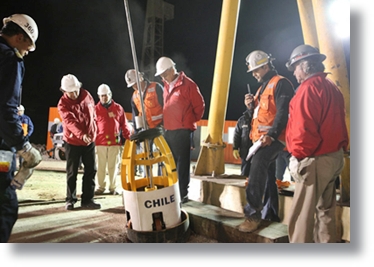Lessons from the Chilean Mining Accident

 |
Yet, this unprecedented rescue, marked by extraordinary human endurance, team-work, ingenuity and technological expertise, must be seen for what it is—the exception, rather than the rule.
Mining is dangerous work. While miners represent just 1 percent of the global number of workers, they suffer 8 percent of the world’s occupational fatalities. There are other sectors which also are extremely dangerous—agriculture, construction, fishing, transportation and ship breaking among others.
The ILO estimates that some 2.3 million workers die each year from work-related accidents and diseases--some 6,300 people die each day. What’s more, the ILO estimates that there are more than 330 million work accidents every year.
The human cost of this daily tragedy is immeasurable. But the economic cost of working days lost, medical treatment and cash benefits paid out is huge--estimated at 4 per cent of annual global GDP. This exceeds the total value of the stimulus packages introduced in the face of the economic crisis of 2008-09.
New workplace hazards lurk on the horizon. Many occupational hazards remain hidden and ignored, particularly in the informal economy.
Recently the adverse impact of the economic crisis on enterprises has taken its toll on many workers. There is a rise in psychosocial conditions linked to new stresses and strains of work in the global economy.
Occupational safety and health strategies will need to also reflect recent developments in the workforce: increased female participation, continued ageing of the workforce and increasing numbers of migrant workers and outsourced jobs require targeted approaches.
Technological progress, diverse employment arrangements and changing workforce demographics give rise to new challenges—nanotechnology applications, biotechnology and chemical handling among them.
Fortunately in Chile technology triumphed where prevention failed. But this is not always the case. Many of these injuries and fatalities could be avoided if the appropriate measures were adopted.
The tripartite constituents of the ILO—governments, workers and employers—developed a “Convention on a Promotional Framework for Occupational Safety and Health” (No.187) and Recommendation (No.197) in 2006 aimed at placing OSH high on national agendas and promoting the application and ratification of other ILO Conventions on occupational safety and health. These new standards are complemented by the ILO’s other OSH Conventions, including sector-specific standards such as the Safety and Health in Mines Convention (Convention No. 176) developed in 1995. Such standards serve to shape legal and regulatory frameworks around the world.
The message from San Jose is that it is time to make a concerted effort to ensure that occupational safety and health is an integral element of strategies for enterprise upgrading and increased productivity. All of us—workers and their families, enterprises, societies and economies—stand to benefit.
Occupational health and safety is one of the areas where we can all agree. No one benefits from casualties in the workplace. Improving OSH makes political, social and economic sense. But translating this consensus into concrete measures is not always simple and will always involve several stakeholders.
Governments can put in place the necessary framework and make sure that it is respected. Companies can apply the managerial and technical expertise needed to implement that framework in each workplace, in dialogue with their workers. Workers can contribute greatly to the prevention of accidents through active participation in risk control, following procedures and engaging in an open dialogue with management on what works and what doesn’t. Only by working together can those statistics be turned around.
Perhaps one of the most significant contributions the 33 Chilean miners made to the future of occupational safety and health is to focus new global attention on the need to ensure more safety, more protection and more prevention when we talk about work done in dangerous conditions, and to promote the ratification of relevant ILO Conventions as a consensus for all concerned.
At the same time, Chilean President Sebastián Piñera has shown the way by announcing the decision by Chile to ratify ILO Convention No. 176, adding (as quoted by The Guardian, UK), that we "cannot guarantee that we will not have accidents in the future, but we can guarantee that we will do whatever is necessary to have a more secure mining industry."
For our part, the ILO can also guarantee full support for a reinforcement of national OSH systems and programmes. International labour standards provide the basic framework in this connection and a key step is the formulation of strong national OSH policy, involving the ILO's government, employer and worker members, and covering all industries and workers.
The last of rescued miners said of the accident, “I hope this never happens again”. There are many ways we can work towards achieving that miner’s hope. Ratifying ILO Conventions is one of them. We have the tools and know-how to do it. What we need is the will to make it so.
By Juan Somavia.
The author is Director-General of the International Labour Organization.
